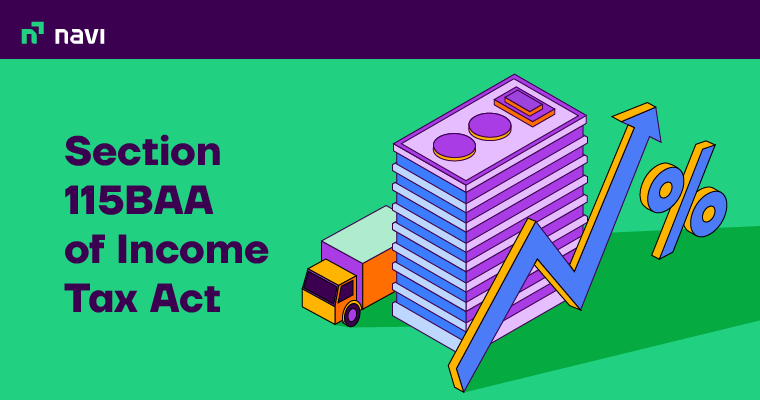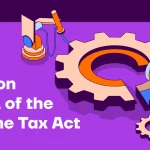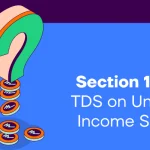Section 115BAA of Income Tax Act: Features and Eligibility

What Is Section 115BAA of Income Tax Act?
The Government of India brought in multiple amendments to the Income Tax Act of 1961 through the Taxation (Amendment) Ordinance 2019. Through Section 115BAA of the Income Tax Act, the government introduced a tax-efficient way for companies to report their income in a bid to promote their growth and global competitiveness.
Section 115BAA of the Income Tax Act has been introduced to lower the corporate tax rate for Indian firms. The amendment has paved the way for domestic companies to pay tax at a rate of 22%, along with a surcharge of 10% and a cess of 4% instead of the standard corporate tax rate of 30% in India. This new corporate tax structure became applicable from FY 2019-2020. This blog provides a comprehensive rundown of Section 115BAA of Income Tax Act.
Features of Section 115BAA of Income Tax Act
- Indian companies can pay corporate tax at a rate of 22% plus 10% surcharge and 4% cess
- This makes the new effective tax rate to be 25.17% (instead of 30%)
- If a company chooses to pay tax under Section 115BAA, they don’t have to pay tax under Minimum Alternate Tax (MAT)
- In the same amendment, the minimum alternate tax rate was also lowered to 15% from 18.5%
- Companies can opt out of concessional tax and return to the previous tax regime
Condition of Section 115BAA Applicability
According to the new tax regime, all domestic companies can pay income tax with a 22% tax rate (with applicable cess and surcharge). However, companies need to forego the following deductions under the Income Tax Act:
- Deductions under Section 10A for Special Economic Zones (SEZ)
- Additional depreciation under Section 32A and investment allowance for setting up industries (Section 32AD) in notified backward areas of West Bengal, Telangana, Bihar and Andhra Pradesh
- Deductions that fall under Section 33AB for rubber, tea, and coffee
- Deductions under Section 35 for expenditure for scientific research and research-specific expenses paid to any university
- Capital expenditure of any specific business under Section 35AD
- Deductions under Section 35CCC and Section 35CCD for expenses incurred on agriculture extension projects or skill development programmes.
- All deductions under Chapter VI A, other than the sections of 80JJAA, 80 LA and 80M.
- Concessions for losses and unabsorbed depreciation under Section 72A.
Also Read
Eligibility Criteria for Section 115BAA
Domestic companies have the option to pay income tax under the new tax rates as introduced through the Section 115BAA, provided they fulfil the following conditions:
- Those companies that seek to pay tax as per Section 115BAA should not ask for other incentives or exemptions under any other provisions of the I-T Act. These companies have to compute their total incomes without claiming the following:
- Any deductions that are available for companies that have been established in special economic zones u/s 10AA
- Additional depreciation as in Section 32 and any investment allowance u/s 32AD for new plant or machinery in specific backward regions of states such as Bihar, Telangana, Andhra Pradesh, and West Bengal
- Any deductions under Section 33AB for companies engaging in coffee, rubber, or tea production
- Any kind of deductions as per Section 35AD for capital expenditure of specific businesses
- Deductions as per Section 35 for expenses towards scientific research or any amount provided to research institution, university, or IITs
- Deductions for deposits that any company associated with the extraction of fossil fuel makes to a site restoration fund as per Section 33ABA
- Any deductions as per Chapter VI-A on certain incomes, permissible under Section 80AC, 80IAC, 80IB, 80IA, and others (Exceptions include deduction as per Section 80M and 80JJAA)
- Deductions or benefits under Section 35CCC for agricultural extension projects or for any skill development project u/s 35CCD
- Any set-off for losses carried forward or any depreciation from the previous years, if these losses happened with respect to deductions mentioned above
- Set-off of losses carried forward by an amalgamated company or any depreciation of an amalgamating company if such depreciation or losses take place with respect to the above-mentioned deductions.
- Companies should not claim any set off for losses mentioned above if they opt for new tax rates under Section 115BAA
- Domestic companies have to choose the option of taxation under Section 115BAA either on or before the last date of filing IT returns. This date is usually September 30 of a particular assessment year. Once a company chooses taxation under this section, it cannot be changed or withdrawn later on
- There are no restrictions regarding the turnover of a domestic company
- Both existing and new companies can opt for taxation under Section 115BAA
Tax Rate for Domestic Company Under Section 115BAA of the Income Tax Act
| Conditions for Domestic Company | Income Tax Rate (excluding cess) |
| When the previous year’s turnover or gross revenue does not reach ₹400 crore | 25% |
| The company has opted for section 115BA | 25% |
| The company has opted for section 115BAA | 22% |
| The company has opted for section 115BAB | 15% |
| Other domestic company | 30% |
The new tax rate for domestic companies under Section 115BAA will be 25.168%. Here is a detailed breakup of the new tax rate under this section:
| Base Tax Rate | Applicable Surcharge | Cess | Effective Tax Rate |
| 22% | 10% | 4% | 22×1.1×1.04= 25.168% |
Also Read
Comparison of Tax Rate With and Without Opting for Section 115BAA
| Total Income | Effective Tax Rate (inclusive of surcharge and cess) | Effective Tax Rate (inclusive of surcharge and cess) |
| Co. opts for section 115BBA | Co. doesn’t opt for section 115BBA | |
| Up to ₹1 crore | 25.17% | 26% |
| More than ₹1 crore but up to ₹10 crore | 25.17% | 27.82% |
| More than ₹10 crore | 25.17% | 29.12% |
Though the effective tax rate in case a company opts for Section 115BAA is slightly lower, such companies will not be able to claim other tax benefits available under the Income-tax Act. If a company does not opt for Section 115BBA can claim specified deductions, incentives, exemptions and additional depreciation available under the Income-tax Act.
Exemptions or Deductions not Available to Companies Opting for Sections 115BA, 115BAA, or 115BAB
| Section 10AA | Special provision for units established in Special Economic Zones (SEZ) |
| Section 32(1)(ii-a) | Additional depreciation in respect of new plant and machinery |
| Section 32AD | Deduction for investment in new plants and machinery in notified backward areas |
| Section 33AB | Deduction in case of tea, coffee, or rubber business |
| Section 33ABA | Deduction in respect of business consisting of prospecting or extraction or production of petroleum or natural gas in India |
| Section 35(1)(ii) | Deduction for donation made for scientific research to a university or other institutes which may or may not be related to business |
| Section 35(1)(iia) | Deduction for payment made to an Indian company for doing scientific research which may or may not be related to business |
| Section 35(1)(iii) | Deduction for donations made to a university, college or other institutes for doing research in the fields of social sciences or statistics |
| Section 35(2M) | Deduction for donation made to National Laboratory or IlTs, etc. for doing scientific research which may or may not be related to business |
| Section 35(2AB) | Deduction for capital expenditure (excluding the cost of land and building) on scientific research related to business of biotechnology or manufacturing of any article or thing |
Final Word
Domestic companies looking to benefit from the reduced tax rates under Section 115BAA of the Income Tax Act need to fulfil certain requirements first. Existing companies can easily migrate to this new tax regime at any point in time. However, if a company chooses the new tax regime over the existing one, it won’t be able to take advantage of other tax benefits under the I-T Act. Companies wishing to opt for Section 115BAA of the Income Tax Act should fill out Form No. 10-IC and submit it online after logging into the e-filing portal.
Need funds to expand your business or explore a new opportunity? Be it for operating expenses, inventory expansion, or acquisition, with Navi Instant Personal Loan, starting at an attractive rate of 9.9% p.a., you can get cash of up to ₹20 Lakh instantly. Download the Navi App today to get started!
FAQs
Ans: Yes, domestic companies who do not want to avail themselves of reduced tax rates under this section can choose to opt-out. However, they need to do it after the expiry of their tax holiday period. But, once a company opts for tax rates under this section, it cannot withdraw it subsequently.
Ans: Domestic companies that fulfil the above-mentioned eligibility criteria qualify for availing concessional tax rates u/s 115BAA. In other words, partnership firms, individuals, LLPs, foreign companies, BOI, and AOPs are not eligible to enjoy reduced tax rates under this section.
Ans: According to Rule 21AE of the Income Tax Act, a domestic company has to opt for Section 115BAA electronically. They can do so by providing details in Form 10-IC either with a digital signature or through electronic verification mode.
Ans: No, domestic companies choosing to pay tax at reduced rates under Section 115BAA cannot claim MAT credits for the tax they paid under MAT in the tax holiday period. Companies won’t be able to lower their tax liability through Section 115BAA if they claim MAT credits. CBDT will issue a clarification about MAT credit for companies that choose taxation u/s 115BAA.
Ans: No, even if a domestic company chooses to opt for taxation at concessional rates as per Section 115BAA, there would be no impact on capital gains tax. Similarly, there would be no impact on bringing forward losses under the ‘Capital Gains’ head.
Disclaimer
This article is solely for educational purposes. Navi doesn't take any responsibility for the information or claims made in the blog.
Read More on Income Tax Act

What is Form 26QB for TDS? How to Download and Submit it?
While purchasing a property, buyers are liable to pay various taxes. The Finance Act, 2013 made TDS... Read More »PF Withdrawal Rules 2023 – Rules, Documents Required and Types
EPF/PF Withdrawal Employees’ Provident Fund (abbreviated as EPF) is a popular retirement sav... Read More »Stamp Duty and Property Registration Charges in Delhi 2023
It is compulsory for property buyers in the Capital to pay stamp duty in Delhi during property regi... Read More »Income Tax Return – Documents, Forms and How to File ITR Online AY 2023-24
In India, it is mandatory for all taxpayers who earn more than the basic tax exemption limit to fil... Read More »What is Section 80CCD – Deductions for National Pension Scheme and Atal Pension Yojana
The Income Tax Act provides a number of deductions and tax benefits to taxpayers, so they can strat... Read More »Tax on Dividend Income: Sources, Tax Rate and TDS on dividend income
What are Dividends? Companies may raise funds for running their operations by selling equity. Th... Read More »Section 112A of Income Tax Act: Taxation on Long-Term Capital Gains
What is Section 112A? Section 112A of the Income Tax Act was announced in Budget 2018 to replace... Read More »Section 206AB of Income Tax Act: Eligibility And TDS Rate
Section 206AB was introduced in the Finance Bill 2021 as a new provision pertaining to higher deduc... Read More »What is a Credit Note in GST – Example, Format and Steps
A GST Credit Note is mandatory for any GST-registered supplier of goods or services. As a supplier,... Read More »Exemptions and Deductions Under Section 10 of Income Tax Act
What Is Section 10 of the Income Tax Act? Section 10 of the Income Tax Act, 1961 provides tax-sa... Read More »Section 57 of the Income-tax Act – Income from Other Sources
It is quite likely that many entities - individuals as well as businesses - have multiple sources o... Read More »What is Dearness Allowance? – Types, Calculation, and Current Rate
What is Dearness Allowance? Dearness Allowance Meaning - Dearness Allowance (DA) is an allowance... Read More »Top 10 Chit Fund Schemes in India in 2023
Chit funds are one of the most popular return-generating saving schemes in India. It is a financial... Read More »10 Best Gold ETFs in India to Invest in April 2023
Gold ETFs or Gold Exchange Traded Funds are passively managed funds that track the price of physica... Read More »10 Best Demat Accounts in India for Beginners in 2023
Creation of Demat accounts revolutionised the way trades were conducted at the stock exchanges. It... Read More »20 Best Index Funds to Invest in India in April 2023
What is an Index Fund? An index fund is a type of mutual fund or exchange-traded fund (ETF) that... Read More »Best Arbitrage Mutual Funds to Invest in India in April 2023
Arbitrage funds are hybrid mutual fund schemes that aim to make low-risk profits by buying and sell... Read More »10 Best SIP Plans in India to Invest in April 2023
What is SIP? SIP or Systematic Investment Plan is a method of investing a fixed amount in ... Read More »10 Best Corporate Bond Funds in India to Invest in April 2023
Corporate bond funds are debt funds that invest at least 80% of the investment corpus in companies ... Read More »10 Best Bank for Savings Account in India [Highest Interest Rate 2023]
Savings account is a type of financial instrument offered by several banks. It lets you safely depo... Read More »


































